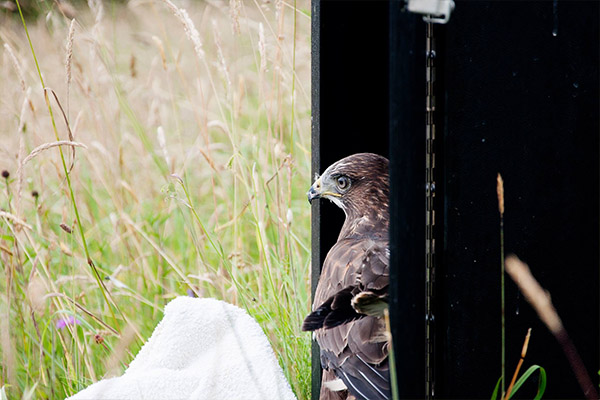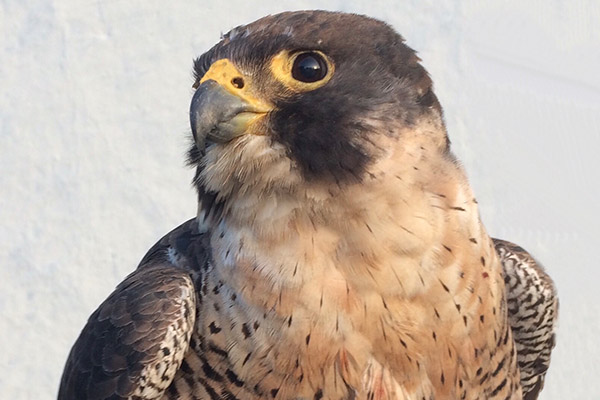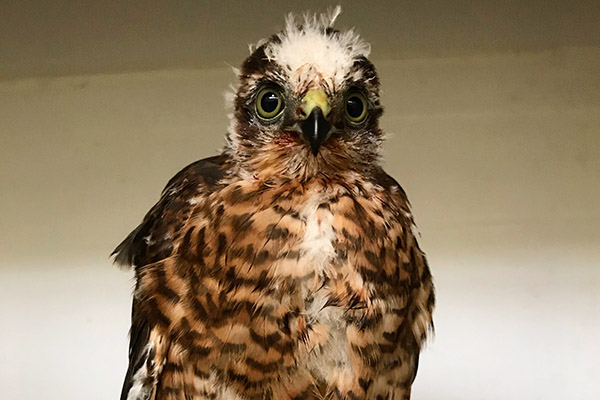Falconry and Conservation
Rehabilitation, one falconer and a kestrel
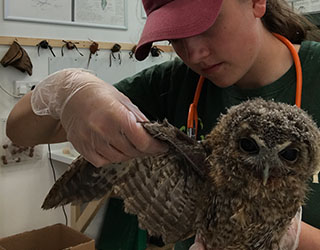
I have always been around the rehabilitation of birds of prey, since my first introduction to falconry when I was fifteen years old. To me, falconry and conservation go hand in hand.
The conservation of hawks and their quarry is at the forefront of a falconer's mind, and falconry is an essential aspect of conservation; not just in conserving birds of prey, but also the habitats and entire ecosystems that they thrive in.
I run a small bird of prey centre as well as a rehabilitation programme for wild raptors. Our mission is in conservation, rehabilitation and education - so much so, I probably utter those three words in my sleep! We are always trying to increase our contribution to the sustainability of wildlife and falconry in every way possible.
In 2019, we dealt with over 60 different rehab cases. Often driving miles out to the middle of nowhere at very unsociable hours. In 2020, we still managed a similar number of rehab cases, whilst re-building our on-site treatment facilities for wild birds.
Alongside raising awareness of sustainable habitat management, rehabilitation not only returns a potential breeding individual to the wild, but gets people talking about conservation and threatened species. Many of our British raptors are in decline. Kestrels for example, are amber listed for conservation concern in the UK, alongside several other species. Threatened by habitat loss and toxic rodent poisons, they have declined by over 30% in 30 years. Some areas ares seeing a nearly 80% decline.
We had an intriguing case last year – of a fledgling kestrel with retinal hypoplasia. This means that the retinas had not developed properly, so the bird was almost blind. By compiling evidence with other cases, our vet believes consumption of some types of rodenticide when the female kestrel is either developing eggs or feeding chicks at 1-2 days old can cause the optical development in the young to stop all together. They are reared by the parents for nearly 2 months and when it comes to branching their environment, with no concept of vision, they fall to their deaths.
Only a falconer can successfully rehabilitate birds of prey. Only a falconer can assess the condition, behaviour and hunting capability of a hawk. Only a falconer can bring a hawk back into fine hunting condition by training it as their partner, and prove without doubt that this hawk is capable of independent survival in the 'wild'.
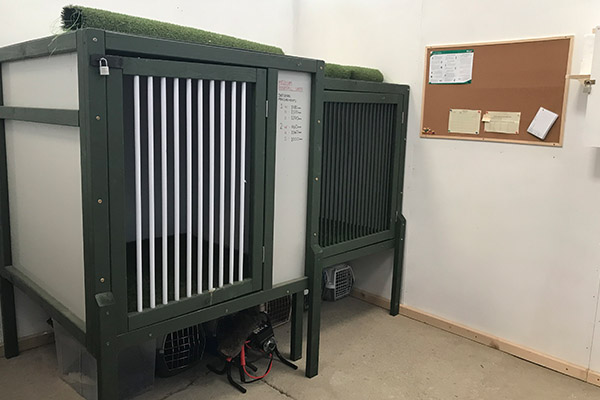
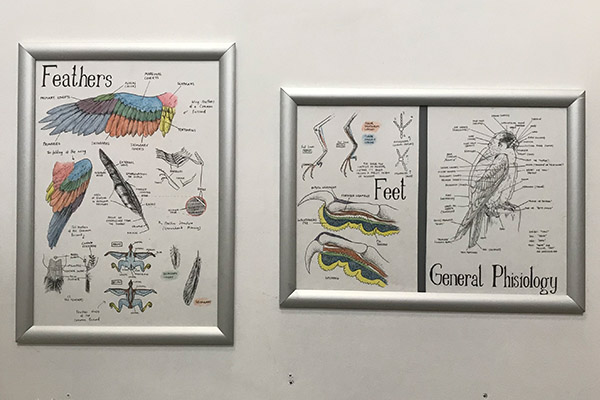
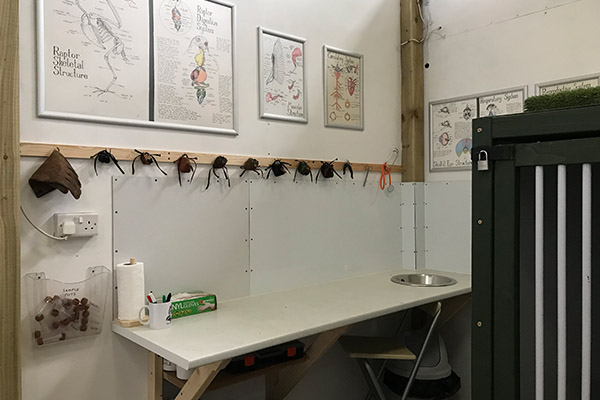
Our dedicated 'Rehabilitation Hospital' provides housing for up to six different cases at any one time. I am very lucky to have a fantastic avian vet who supports us to no end with our work in rehabilitation. We see all sorts of cases, from orphaned chicks, to starvation, fractures, toxin ingestion and more, yet there is still an awful lot more I haven't encountered and know very little about. Rehabilitation starts off as a mystery – sometimes the reason behind their poor condition is pretty obvious, but not always. For each case we run full examinations, initial treatments and basic clinical tests on site, before our vet carries out further examination, including radiography and blood sampling.
Once a course of treatment has been prescribed, we care for the patient in seclusion in our Rehabilitation Hospital. Sometimes, it is a quick fix. A few days or a couple of weeks and the patient is ready to be released in a safe location near where they were found. Sometimes the condition of the patient is far too severe and the only ethical option is euthanasia. Sometimes, patients are with us for a long time – or even once they have recovered from their initial injury or illness, they are not capable of surviving in the wild. It is cases like these, which falconry is essential for.
Generalising here, there are two types of cases that we would look at falconry techniques for. It should also be mentioned that some species are not suited to this type of rehabilitation – for example owls who will be much more suited to a soft release, hack back routine.
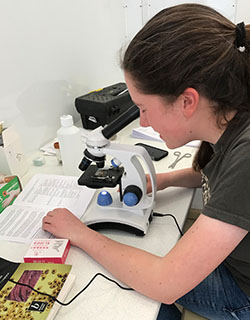
(From now on, when I use the word 'hawk' I am referring to a variety of falconry birds – from falcons to buzzards to the true hawks such as goshawks or sparrowhawks.)
Firstly - a young juvenile hawk which has not succeeded in surviving their first winter. This could be an orphaned fledgling who has needed treatment for an injury and as a result lost the opportunity to learn crucial survival and hunting skills from their parents. Or it could be a fledged juvenile suffering from starvation after the easier meals (such as summer mice and voles) have disappeared, and only the large, strong and powerful prey items remain to be caught.
Secondly - any hawk who has sustained a serious loss of muscle. This is usually just because they have been in rehabilitation for such a long time, that they have lost the high level of muscle required to hunt successfully in the wild. The best analogy I could use to describe this is, imagine recovering from a broken leg. You've been 'discharged' by your doctor after months of treatment and a final x-ray showing that the bone has healed and your leg is no longer broken. Imagine I then told you to run a marathon the next day – you'd laugh in my face. Simply releasing a bird back to the wild after months of treatment is a similar sort of concept.
The most recent case I rehabilitated using falconry was a young kestrel, which I left behind in his wild territory for the last time just before Christmas 2020.
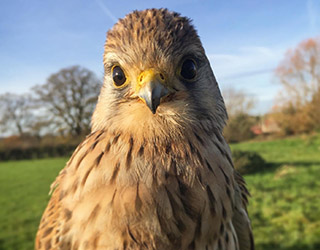
This kestrel came in to us in September of 2020, unable to get off the ground. Not particularly starved, lethargic or weak. He wasn't carrying a burden of intestinal parasites. Radiographs and further examinations found nothing wrong with him. He was perhaps the smallest male kestrel I had ever treated, weighing in at less than 150 grams once he was as plump as they get! He was a juvenile, but a handful of moulted feathers proved that he was just over a year old.
After another week he started moving around and could once more get about an aviary again. But he was starved of muscle and we were still none the wiser as to why he came in the way he did. I decided to step in, as I couldn't warrant releasing a juvenile in that condition. Essentially, I will become his falconer, his companion, and he will be trained as my hawk. Until I can see that he is fit and strong on the wing again, and hunting for himself, I will be acting as his safety net. Once he is ready, I will gradually re-introduce him to his wild territory. He will no longer rely on me and will be fully independent again. That way his first free flight, does not have to be his last.
I am often asked, surely by training a wild bird I am imprinting it, or denying it any normal existence as a wild bird of prey. This couldn't be further from the truth. Yes, I do establish a relationship and bond of trust with a wild hawk, but this is not imprinting. It is a process of conditioning that is entirely reversable. Once the hawk gradually regains independence, their 'wildness' will gradually return, until I am of no service to them once more. And this process is what gives the young hawk the best chance of a normal and successful survival in the wild. The only thing he will take away with him other than a second chance at life, is a little aluminium ring to identify him should he ever be spotted again by (excuse the pun) an eagle-eyed twitcher or photographer.
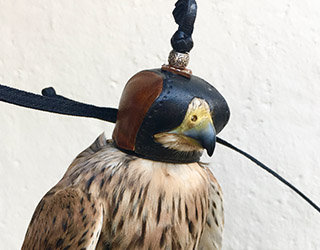
The first stage of the falconry process with this young kestrel, is forming a basic relationship of trust and understanding between the two of us. Each day is a lesson for him, and I must treat him with the greatest kindness and respect to ensure he learns the right lesson. He learns that I am of no danger to him, and that he can gain a meal from my fist.
The use of a falconry hood is essential for his welfare, allowing me to safely transport him, alongside accurately assessing his muscle development around his keel bone and legs.
We now progress to using the lure – a small leather pad with an enticing meal attached to it. He is trained to fly to the lure, and eventually I will swing the lure, encouraging him to pass to it, gain distance and height from it. The lure is the tool I will use to set him up in a hunting environment when he is ready.
Initially I use a training line (falconers call it a creance) to teach him the principle of what the lure is, and to encourage him to fly short distances to it. With careful respect and attention to detail on my part, he allows me to help him feed and happily trades the remainder of his meal on the lure of a portion on my fist.
After a couple of weeks, he is ready to fly free. I use a telemetry transmitter and a bell at this stage, so not to lose him just yet. Each day from now on, I push his fitness as hard as I can, looking to see him out of breath each day. Flying him twice a day, with a high protein and rodent based diet, his weight creeps up as muscle starts to build around his skeleton once more.
Strong wind and rain are excellent opportunities to build his abilities, and we never miss a chance with these weather conditions. Even if I end up soaked through! In flashes, I see his natural abilities returning – hovering over a hedgerow and using uplift to gain height. Now it is time to encourage hunting.
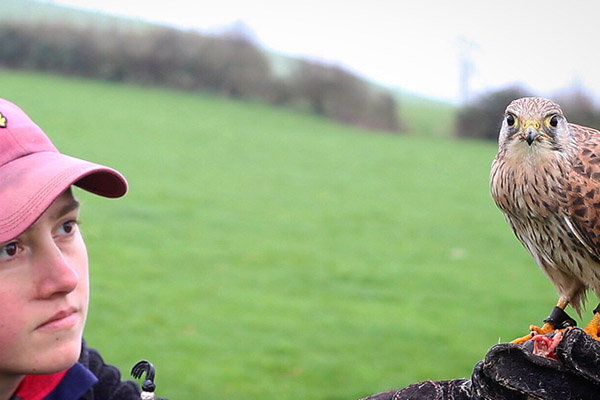
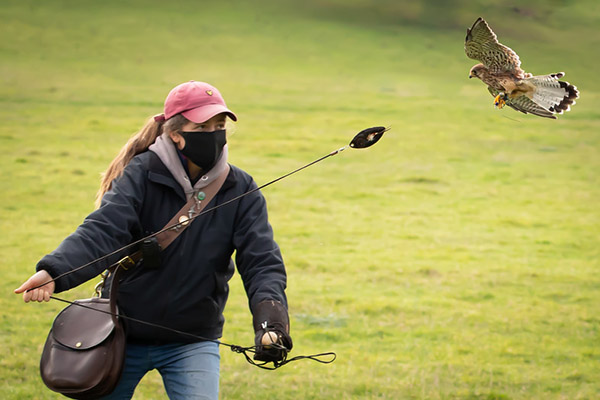
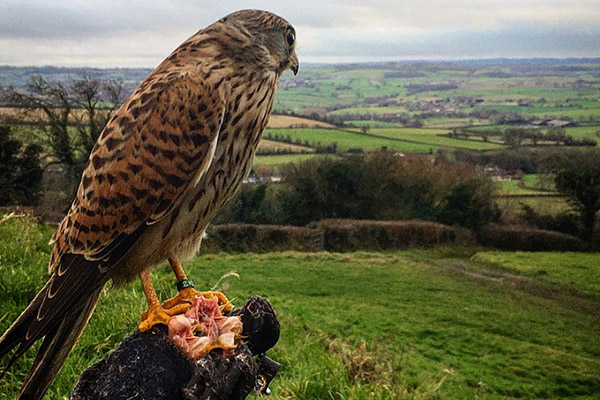
We find hilly ground with plenty of long grass and hedgerows. He knows to gain height, anticipating the lure, but this time I refuse him the lure and walk through the long grass instead, away from him. He starts to rake away (a falconry term referring to a hawk flying away into the distance from their falconer). I give him more time to himself, more independence, and soon enough he starts trying to catch his own food. Falconers serve prey for their hawks - I can't be all that successful doing this with mice and insects, so the lure training allows me to set him up in an area where he can be encouraged to hunt for himself.
As he has already survived his first winter, the final stage of acclimatising him to his former territory is quite quick. We returned to an area close by where he was found, I spend a lot of time working out whether the site is best for the bird in question. Inevitably there will be some territorial fights ahead for the young kestrel, but he is now fit, strong and capable of standing a good chance.
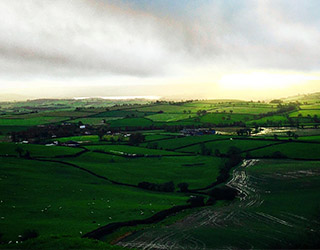
Over several days I release him over his wild territory, allow him to explore for a while, before calling him into the lure and taking him back home. Day by day he becomes more reluctant to return and more wary of me. Finally, I decide he is as ready as he will ever be to stay out overnight. By now, his falconry furniture (anklets, jesses and bell) and telemetry device have been removed. He enjoys several mice on my fist before deciding he no longer appreciates my company and decides to part ways. I watch him fly into the sunset and find a tree to spend the night. Then I gather my things and head home.
The next morning, I had no luck in finding him. No sign, nothing. Later that day, after an hour of throwing the lure out I also had no luck. But then I spotted a kestrel hovering just to the left of me. I called him in and he headed toward the lure, but veered off at the last moment. I then sat back and watched the same kestrel that couldn't get off the ground for three days now hover, soar and stoop in the strong wind over the valley, diving into the grass. Hunting a late meal in the sunset. He eventually disappeared out of view, but I knew he was now capable without me.
It is thanks to falconry, the art of hunting with birds of prey, that stretches so far back into British and international history, that this kestrel had a second chance at life. There is every chance he will go on to reproduce for his species. I hope that we continue to protect their habitats, so the work of the humble kestrel to preserve their species isn't in vain.
Kestrels are one of many species we work with in rehabilitation, and this particular case was one of several that have been saved by falconry. Falconry and conservation go hand in hand. Without one, we cannot have the other.
